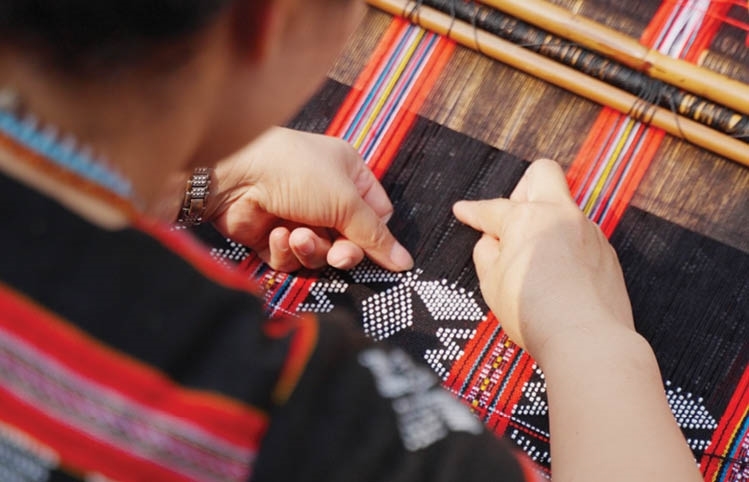 |
| Ta Oi Girls Weaving Threads into Zèng Fabrics. Photo: Duc Hieu |
The Spring Festival Colors
From early morning, crowds of people flocked to the Cultural Village of Ethnic Minorities in Hong Thuong Commune. Along the road to the village center, locals dressed in traditional clothing and elegant Zèng tunics brightened the entire scene. Booths displaying highland agricultural products and specialties drew visitors in for browsing and shopping. These festivals not only promote local goods but also boost incomes and help develop community-based tourism.
Traditional rituals of the Pa Co, Ta Oi, and Co Tu peoples - such as the Zèng Offering, Âr Pục (Unity) Festival, and An Ninh - were faithfully recreated. Folk melodies echoed through the forest as rhythmic dance steps delighted spectators. During the festive days, visitor didn’t just watch - they could take part in ceremonies, try weaving Zèng, make Aquát cakes, and join in traditional games. Pa Co, Ta Oi, Co Tu, and Pa Hy children proudly showed off handcrafted items they had made themselves.
Ms. Le Thi Them, head of the Department of Culture, Science, and Information in A Luoi District, shared: “These days, traditional festivals and customs are being revived and their value promoted. We're not just preserving them - we’re refreshing them to attract tourists and create sustainable livelihoods for locals. The festival is a special cultural event, an opportunity to boost tourism in A Luoi.”
Master artisan and village elder Nguyen Hoai Nam from Hong Ha Commune beamed with joy at the sight of bustling village lanes: “In the past, our dances and songs were only performed during traditional ethnic festivals. Now, even on regular days, we get to perform for visitors. It’s wonderful! Elders relive old memories, while the younger generation feels more connected to and proud of their heritage.”
 |
| Each pattern tells a story of the land, the forest, and the life of the Ta Oi people |
An Unforgettable Impression
At the Ta Oi traditional house, we stopped where Ta Oi women sat intently at their looms. The rhythmic clicking of weaving tools harmonized with the festive atmosphere, creating a melody that was both familiar and new. Colorful Zèng fabrics slowly emerged from the nimble hands of young women.
One girl looked up and smiled, “Would you like to try weaving Zèng?” I hesitated, then nodded and sat down at the loom. She introduced herself as Ho Thi Truyen, 22, from a family with a long Zèng-weaving tradition. Gently, she guided me on threading the yarn through wooden rods with smooth coordination. I tried to follow her instructions, but the threads kept tangling with each shuttle pass.
“Everyone struggles at first! But once you get used to it, weaving Zèng is like painting. Each pattern is a story - of land, of forest, of the Ta Oi way of life.”
I smiled at Truyen, captivated as I watched the patterns take shape on the Zèng fabric she was weaving. It wasn’t just simple stripes - there were suns, flowing streams, and forest flowers, all interwoven into a richly meaningful tapestry. Truyen brought out an Ao dai made from Zèng, its hem adorned with intricate motifs in warm, earthy tones but still exuded softness and elegance. I gently touched the fabric, feeling the rustic texture of the threads - and within it, the breath of the mountains and forests.
"We even sell online now!" Truyen said enthusiastically. "We’ve set up online shops, livestream our products, and sometimes even guide customers on how to style outfits with Zèng. At first, not many people knew about it, but now a lot of people love it - both locals and foreigners."
How surprising! These young women aren’t just preserving tradition - they’re sharing their culture with the world in a truly modern way. The sun was already high, yet I remained there, immersed in Truyen’s story. In her eyes, shone pride and a deep desire to preserve and spread the beauty of her heritage - so that Zèng isn’t just a relic of the past, but a living part of today’s and tomorrow’s life.
The “Spring Colors of A Luoi” festival came to a close in joy and lingering emotion. A Luoi today is different - fresh and vibrant, yet still preserving the untouched soul of the mountains and forests. And I know for certain, I’ll return to this place - to once again lose myself in the enchanting breath of the great highlands.